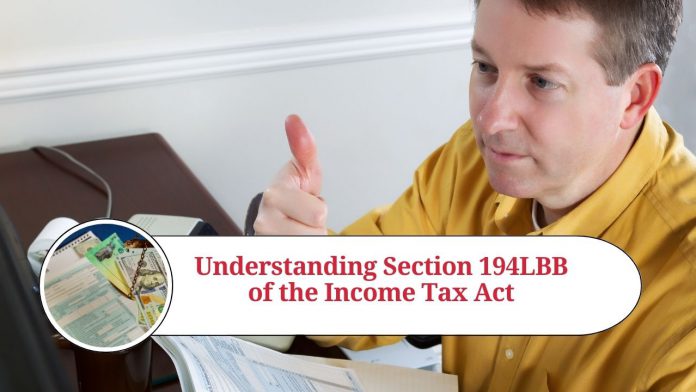Section 194LBB of the Income Tax Act is a provision that deals with the taxation of income earned by certain specified investment funds. In this blog, we will explore the key features of this section and how it affects investors and investment funds.
Introduction to Section 194LBB
Section 194LBB was introduced in the Income Tax Act in 2015 to provide a special tax regime for certain types of investment funds. This section applies to income distributed by an investment fund to its unit holders. The income is subject to withholding tax at the rate of 10%.
The section applies to investment funds that are set up as a Category I or Category II alternative investment fund (AIF) under the Securities and Exchange Board of India (SEBI) Regulations, 2012. The funds must also be registered with the SEBI.
Key Features of Section 194LBB
- Applicability: As mentioned earlier, section 194LBB applies to Category I and Category II alternative investment funds that are registered with the SEBI. The section does not apply to other types of investment funds or to individual investors.
- Withholding tax: The section requires the investment fund to deduct withholding tax at the rate of 10% before distributing the income to the unit holders. The tax is deducted at the time of payment or credit of the income, whichever is earlier. The tax is then remitted to the government by the investment fund.
- Income covered: The section applies to all types of income distributed by the investment fund to its unit holders. This includes interest, dividend, capital gains, and any other income.
- Exemptions: Section 194LBB provides for certain exemptions from withholding tax. For example, if the unit holder is a resident individual or Hindu Undivided Family (HUF) and the total amount of income distributed by the investment fund during the financial year is less than Rs. 5,000, then no tax is deducted. Similarly, if the unit holder is a non-resident and the income is covered under the provisions of the Double Taxation Avoidance Agreement (DTAA) between India and the country of residence, then the tax rate may be lower than 10%.
Impact of Section 194LBB on Investors and Investment Funds
For investors, section 194LBB means that they will receive their income from the investment fund net of tax. This means that they do not have to worry about paying tax on the income separately. However, if the investor falls in a higher tax bracket than the withholding tax rate, they may have to pay additional tax on the income when they file their income tax returns.
For investment funds, section 194LBB means that they have to deduct and remit tax on the income distributed to the unit holders. This requires them to maintain proper records of the income and the tax deducted. Failure to comply with the provisions of section 194LBB can result in penalties and interest.
Conclusion
Section 194LBB of the Income Tax Act provides a special tax regime for certain types of investment funds. The section requires investment funds to deduct withholding tax at the rate of 10% before distributing income to unit holders. The section has a significant impact on both investors and investment funds, and it is important for them to understand the provisions of this section to avoid any penalties or interest.
Read more useful content:
- section 234e of income tax act
- section 286 of income tax act
- section 90a of income tax act
- section 40a(7) of income tax act
- section 226(3) of income tax act
- section 24 of income tax act
Frequently Asked Questions (FAQs)
Q: What is Section 194LBB of the Income Tax Act?
A: Section 194LBB of the Income Tax Act is a provision that deals with the tax deduction at source (TDS) on income received by a unitholder from a specified investment fund.
Q: What is a specified investment fund under Section 194LBB?
A: A specified investment fund is a fund that is set up as a Category I or Category II Alternative Investment Fund (AIF) and invests in start-ups or early-stage ventures.
Q: Who is required to deduct TDS under Section 194LBB?
A: The person responsible for making the payment to the unitholder is required to deduct TDS under Section 194LBB.
Q: What is the rate of TDS under Section 194LBB?
A: The rate of TDS under Section 194LBB is 10%.
Q: Is there any threshold limit for TDS deduction under Section 194LBB?
A: No, there is no threshold limit for TDS deduction under Section 194LBB. TDS is to be deducted on the entire amount of income paid to the unitholder.
Q: Is it mandatory for the specified investment fund to furnish a TDS certificate to the unitholder?
A: Yes, it is mandatory for the specified investment fund to furnish a TDS certificate to the unitholder in Form 16D.




















